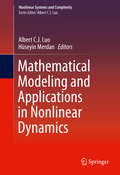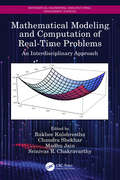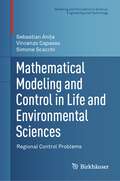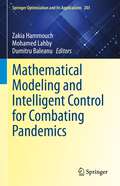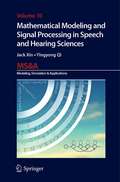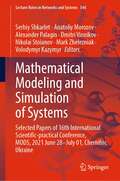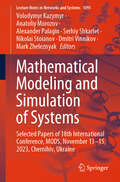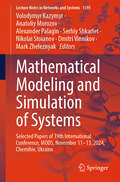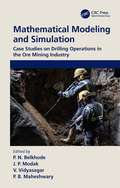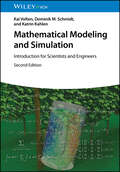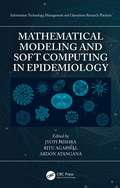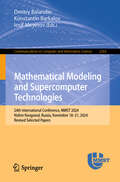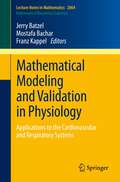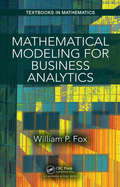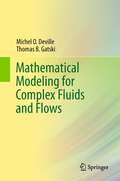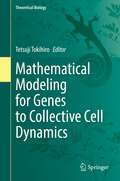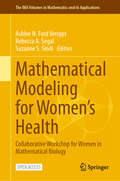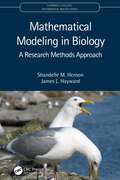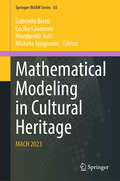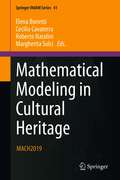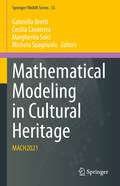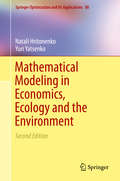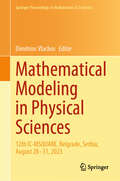- Table View
- List View
Mathematical Modeling and Applications in Nonlinear Dynamics
by Albert C.J. Luo Hüseyin MerdanThe book covers nonlinear physical problems and mathematical modeling, including molecular biology, genetics, neurosciences, artificial intelligence with classical problems in mechanics and astronomy and physics. The chapters present nonlinear mathematical modeling in life science and physics through nonlinear differential equations, nonlinear discrete equations and hybrid equations. Such modeling can be effectively applied to the wide spectrum of nonlinear physical problems, including the KAM (Kolmogorov-Arnold-Moser (KAM)) theory, singular differential equations, impulsive dichotomous linear systems, analytical bifurcation trees of periodic motions, and almost or pseudo- almost periodic solutions in nonlinear dynamical systems.
Mathematical Modeling and Computation of Real-Time Problems: An Interdisciplinary Approach (Mathematical Engineering, Manufacturing, and Management Sciences)
by Madhu Jain Rakhee Kulshrestha Chandra Shekhar Srinivas R. ChakravarthyThis book covers an interdisciplinary approach for understanding mathematical modeling by offering a collection of models, solved problems related to the models, the methodologies employed, and the results using projects and case studies with insight into the operation of substantial real-time systems. The book covers a broad scope in the areas of statistical science, probability, stochastic processes, fluid dynamics, supply chain, optimization, and applications. It discusses advanced topics and the latest research findings, uses an interdisciplinary approach for real-time systems, offers a platform for integrated research, and identifies the gaps in the field for further research. The book is for researchers, students, and teachers that share a goal of learning advanced topics and the latest research in mathematical modeling.
Mathematical Modeling and Computational Tools: ICACM 2018, Kharagpur, India, November 23–25 (Springer Proceedings in Mathematics & Statistics #320)
by Jitendra Kumar Somnath Bhattacharyya Koeli GhoshalThis book features original research papers presented at the International Conference on Computational and Applied Mathematics, held at the Indian Institute of Technology Kharagpur, India during November 23–25, 2018. This book covers various topics under applied mathematics, ranging from modeling of fluid flow, numerical techniques to physical problems, electrokinetic transport phenomenon, graph theory and optimization, stochastic modelling and machine learning. It introduces the mathematical modeling of complicated scientific problems, discusses micro- and nanoscale transport phenomena, recent development in sophisticated numerical algorithms with applications, and gives an in-depth analysis of complicated real-world problems. With contributions from internationally acclaimed academic researchers and experienced practitioners and covering interdisciplinary applications, this book is a valuable resource for researchers and students in fields of mathematics, statistics, engineering, and health care.
Mathematical Modeling and Control in Life and Environmental Sciences: Regional Control Problems (Modeling and Simulation in Science, Engineering and Technology)
by Sebastian Aniţa Vincenzo Capasso Simone ScacchiThis monograph explores the use of mathematical modeling and control theory in a variety of contemporary challenges in mathematical biology and environmental sciences. Emphasizing an approach of learning by doing, the authors focus on a set of significant case studies emerging from real-world problems and illustrate how mathematical techniques and computational experiments can be employed in the search for sustainable solutions.The following topics are extensively discussed:Eradicability and control of a paradigmatic epidemic model, with a view to the existence of endemic states, their stability, and the existence of travelling wavesA spatially structured epidemic model concerning malaria as an example of vector-borne epidemicsOptimal harvesting problems for space-structured and age-structured population dynamicsControlling epidemics in agriculture due to pest insectsThe role of predators as a possible biocontrol agent of epidemics in agricultureControl by taxation of the environmental pollution produced by human activitiesThe originality of this text is in its leitmotif – regional control – along the principle of “Think Globally, Act Locally.” Indeed, for example, in many real spatially structured ecosystems, it is practically impossible to control the relevant system by global interventions in the whole habitat.Proofs are given whenever they may serve as a guide to the introduction of new concepts. Each chapter includes a comprehensive description of the numerical methods used for the computational experiments, and MATLAB© codes for many of the numerical simulations are available for download. Several challenging open problems are also provided to stimulate future research.This text is aimed at mathematicians, engineers, and other scientists working in areas such as biology, medicine, and economics. Graduate and advanced undergraduate students of a quantitative subject related to the analysis and applications of dynamical systems and their control will also find it to be a valuable resource.
Mathematical Modeling and Intelligent Control for Combating Pandemics (Springer Optimization and Its Applications #203)
by Dumitru Baleanu Zakia Hammouch Mohamed LahbyThe contributions in this carefully curated volume, present cutting-edge research in applied mathematical modeling for combating COVID-19 and other potential pandemics. Mathematical modeling and intelligent control have emerged as powerful computational models and have shown significant success in combating any pandemic. These models can be used to understand how COVID-19 or other pandemics can spread, analyze data on the incidence of infectious diseases, and predict possible future scenarios concerning pandemics. This book also discusses new models, practical solutions, and technological advances related to detecting and analyzing COVID-19 and other pandemics based on intelligent control systems that assist decision-makers, managers, professionals, and researchers. Much of the book focuses on preparing the scientific community for the next pandemic, particularly the application of mathematical modeling and intelligent control for combating the Monkeypox virus and Langya Henipavirus.
Mathematical Modeling and Signal Processing in Speech and Hearing Sciences (Ms&a Ser. #10)
by Jack Xin Yingyong QiThe aim of the book is to give an accessible introduction of mathematical models and signal processing methods in speech and hearing sciences for senior undergraduate and beginning graduate students with basic knowledge of linear algebra, differential equations, numerical analysis, and probability. Speech and hearing sciences are fundamental to numerous technological advances of the digital world in the past decade, from music compression in MP3 to digital hearing aids, from network based voice enabled services to speech interaction with mobile phones. Mathematics and computation are intimately related to these leaps and bounds. On the other hand, speech and hearing are strongly interdisciplinary areas where dissimilar scientific and engineering publications and approaches often coexist and make it difficult for newcomers to enter.
Mathematical Modeling and Simulation of Systems: Selected Papers of 16th International Scientific-practical Conference, MODS, 2021 June 28–July 01, Chernihiv, Ukraine (Lecture Notes in Networks and Systems #344)
by Alexander Palagin Anatoliy Morozov Serhiy Shkarlet Dmitri Vinnikov Nikolai Stoianov Mark Zhelezniak Volodymyr KazymyrThis book contains works on mathematical and simulation modeling of processes in various domains: ecology and geographic information systems, IT, industry, and project management. The development of complex multicomponent systems requires an increase in accuracy, efficiency, and adequacy while reducing the cost of their creation. The studies presented in the book are useful to specialists who involved in the development of real events models-analog, management and decision-making models, production models, and software products. Scientists can get acquainted with the latest research in various decisions proposed by leading scholars and identify promising directions for solving complex scientific and practical problems. The chapters of this book contain the contributions presented on the 16th International Scientific-practical Conference, MODS, June 28–July 01, 2021, Chernihiv, Ukraine.
Mathematical Modeling and Simulation of Systems: Selected Papers of 17th International Conference, MODS, November 14-16, 2022, Chernihiv, Ukraine (Lecture Notes in Networks and Systems #667)
by Alexander Palagin Anatoliy Morozov Serhiy Shkarlet Dmitri Vinnikov Nikolai Stoianov Mark Zhelezniak Volodymyr KazymyrModern complex multi-domain systems require increased efficiency, reliability, and availability combined with reduced cost. This book contains papers on mathematical modeling and simulation of processes in various areas: ecology and the environment, production and energy, information technology, samples of special-purpose equipment, and cyber-physical systems. The outcomes presented in the book are useful to specialists involved in the modeling and simulation of real-world system, management and decision-making models, production models, and software products. Scientists have the opportunity to familiarize themselves with the latest research in a variety of solutions proposed by leading scientists and to determine promising directions for solving complex scientific and practical tasks. Chapters of this book contain papers presented at the 17th MODS International Conference, November 14–16, 2022, Chernihiv, Ukraine.
Mathematical Modeling and Simulation of Systems: Selected Papers of 18th International Conference, MODS, November 13-15, 2023, Chernihiv, Ukraine (Lecture Notes in Networks and Systems #1091)
by Alexander Palagin Anatoliy Morozov Serhiy Shkarlet Dmitri Vinnikov Nikolai Stoianov Volodymyr Kazymyr Mark ZheleznyakModern complex multi-domain systems require increased efficiency, reliability and availability combined with reduced cost. This book contains papers on mathematical modeling and simulation of processes in various areas: in ecology and the environment, production and energy, information technology, samples of special purpose equipment, and cyber-physical systems. The outcomes presented in the book will be useful to specialists involved in the modeling and simulation of real-world system, management and decision-making models, production models, and software products. Scientists have the opportunity to familiarize themselves with the latest research in a variety of solutions proposed by leading scientists and to determine promising directions for solving complex scientific and practical tasks. Chapters of this book contain papers presented at the 18th MODS International Conference, November 13–15, 2023, Chernihiv, Ukraine.
Mathematical Modeling and Simulation of Systems: Selected Papers of 19th International Conference, MODS, November 11–13, 2024, Chernihiv, Ukraine (Lecture Notes in Networks and Systems #1391)
by Alexander Palagin Anatoliy Morozov Serhiy Shkarlet Dmitri Vinnikov Nikolai Stoianov Volodymyr Kazymyr Mark ZheleznyakThis book contains papers on mathematical modeling and simulation of processes in various areas: in ecology and the environment, manufacturing and energetics, information technology, samples of special purpose equipment and cyber-physical systems. In the context of comprehensive digitalization, computer modeling becomes a direct component of creating and operating modern complex multi-domain systems. The outcomes presented in the book will be useful to specialists involved in the modeling of real-world and cyber-physical systems, physical processes simulation, management and decision-making models, functioning and cybersecurity models, modeling software and tools. Scientists have the opportunity to familiarize themselves with the latest research in a variety of solutions proposed by leading scientists and to determine promising directions for solving complex scientific and practical tasks. Chapters of this book contain papers presented at the 19th MODS International Conference, November 11–13, 2024, Chernihiv, Ukraine.
Mathematical Modeling and Simulation: Case Studies on Drilling Operations in the Ore Mining Industry
by Dr P. N. BelkhodeThis book explains the concept of man-machine systems by using the mining industry. The goal is to use a mathematical model based approach to improve the quality of human life of the workers and operators with the enhancement of productivity by controlling the process variables. The book will illustrate the formulation of mathematical modelling for manual operations. It will provide details in the investigation of many machine systems through the case study approach and provide data analysis using the concept of mathematical modelling and sensitivity. It presents how to solve a field problem through a field data-based modelling concept and highlights the collection of anthropometry data and its behavior. The book will be useful for researchers, academic libraries, professionals, post graduate students of Industrial, Mechanical, and Manufacturing Engineering programs.
Mathematical Modeling and Simulation: Introduction for Scientists and Engineers
by Kai Velten Dominik M. Schmidt Katrin KahlenLearn to use modeling and simulation methods to attack real-world problems, from physics to engineering, from life sciences to process engineering Reviews of the first edition (2009): "Perfectly fits introductory modeling courses [...] and is an enjoyable reading in the first place. Highly recommended [...]"Zentralblatt MATH, European Mathematical Society, 2009 "This book differs from almost all other available modeling books in that [the authors address] both mechanistic and statistical models as well as 'hybrid' models. [...] The modeling range is enormous."SIAM Society of Industrial and Applied Mathematics, USA, 2011 This completely revised and substantially extended second edition answers the most important questions in the field of modeling: What is a mathematical model? What types of models do exist? Which model is appropriate for a particular problem? What are simulation, parameter estimation, and validation? What kind of mathematical problems appear and how can these be efficiently solved using professional free of charge open source software? The book addresses undergraduates and practitioners alike. Although only basic knowledge of calculus and linear algebra is required, the most important mathematical structures are discussed in sufficient detail, ranging from statistical models to partial differential equations and accompanied by examples from biology, ecology, economics, medicine, agricultural, chemical, electrical, mechanical, and process engineering. About 200 pages of additional material include a unique chapter on virtualization, Crash Courses on the data analysis and programming languages R and Python and on the computer algebra language Maxima, many new methods and examples scattered throughout the book, an update of all software-related procedures, and a comprehensive book software providing templates for typical modeling tasks in thousands of code lines. The book software includes GmLinux, an operating system specifically designed for this book providing preconfigured and ready-to-use installations of OpenFOAM, Salome, FreeCAD/CfdOF workbench, ParaView, R, Maxima/wxMaxima, Python, Rstudio, Quarto/Markdown and other free of charge open source software used in the book.
Mathematical Modeling and Soft Computing in Epidemiology (Information Technology, Management and Operations Research Practices)
by Jyoti Mishra, Ritu Agarwal, and Abdon AtanganaThis book describes the uses of different mathematical modeling and soft computing techniques used in epidemiology for experiential research in projects such as how infectious diseases progress to show the likely outcome of an epidemic, and to contribute to public health interventions. This book covers mathematical modeling and soft computing techniques used to study the spread of diseases, predict the future course of an outbreak, and evaluate epidemic control strategies. This book explores the applications covering numerical and analytical solutions, presents basic and advanced concepts for beginners and industry professionals, and incorporates the latest methodologies and challenges using mathematical modeling and soft computing techniques in epidemiology. Primary users of this book include researchers, academicians, postgraduate students, and specialists.
Mathematical Modeling and Supercomputer Technologies: 24th International Conference, MMST 2024, Nizhni Novgorod, Russia, November 18–21, 2024, Revised Selected Papers (Communications in Computer and Information Science #2363)
by Iosif Meyerov Dmitry Balandin Konstantin BarkalovThis book constitutes the refereed proceedings of the 24th International Conference on Mathematical Modeling and Supercomputer Technologies , MMST 2024, held in Nizhni Novgorod, Russia, during November 18–21 2024. The 17 full papers and 3 short papers included in this book were carefully reviewed and selected from 39 submissions. They were organized in topical sections as follows: artificial intelligence and supercomputer simulation; computing in optimization and optimal control; computational methods for mathematical models analysis.
Mathematical Modeling and Validation in Physiology
by Mostafa Bachar Jerry J. Batzel Franz KappelThis volume synthesizes theoretical and practical aspects of both the mathematical and life science viewpoints needed for modeling of the cardiovascular-respiratory system specifically and physiological systems generally. Theoretical points include model design, model complexity and validation in the light of available data, as well as control theory approaches to feedback delay and Kalman filter applications to parameter identification. State of the art approaches using parameter sensitivity are discussed for enhancing model identifiability through joint analysis of model structure and data. Practical examples illustrate model development at various levels of complexity based on given physiological information. The sensitivity-based approaches for examining model identifiability are illustrated by means of specific modeling examples. The themes presented address the current problem of patient-specific model adaptation in the clinical setting, where data is typically limited.
Mathematical Modeling for Business Analytics (Textbooks in Mathematics)
by William P. FoxMathematical Modeling for Business Analytics is written for decision makers at all levels. This book presents the latest tools and techniques available to help in the decision process. The interpretation and explanation of the results are crucial to understanding the strengths and limitations of modeling. This book emphasizes and focuses on the aspects of constructing a useful model formulation, as well as building the skills required for decision analysis. The book also focuses on sensitivity analysis. The author encourages readers to formally think about solving problems by using a thorough process. Many scenarios and illustrative examples are provided to help solve problems. Each chapter is also comprehensively arranged so that readers gain an in-depth understanding of the subject which includes introductions, background information and analysis. Both undergraduate and graduate students taking methods courses in methods and discrete mathematical modeling courses will greatly benefit from using this book. Boasts many illustrative examples to help solve problems Provides many solutions for each chapter Emphasizes model formulation and helps create model building skills for decision analysis Provides the tools to support analysis and interpretation
Mathematical Modeling for Complex Fluids and Flows
by Michel Deville Thomas B. GatskiMathematical Modeling for Complex Fluids and Flows provides researchers and engineering practitioners encountering fluid flows with state-of-the-art knowledge in continuum concepts and associated fluid dynamics. In doing so it supplies the means to design mathematical models of these flows that adequately express the engineering physics involved. It exploits the implicit link between the turbulent flow of classical Newtonian fluids and the laminar and turbulent flow of non-Newtonian fluids such as those required in food processing and polymeric flows. The book develops a descriptive mathematical model articulated through continuum mechanics concepts for these non-Newtonian, viscoelastic fluids and turbulent flows. Each complex fluid and flow is examined in this continuum context as well as in combination with the turbulent flow of viscoelastic fluids. Some details are also explored via kinetic theory, especially viscoelastic fluids and their treatment with the Boltzmann equation. Both solution and modeling strategies for turbulent flows are laid out using continuum concepts, including a description of constructing polynomial representations and accounting for non-inertial and curvature effects. Ranging from fundamental concepts to practical methodology, and including discussion of emerging technologies, this book is ideal for those requiring a single-source assessment of current practice in this intricate yet vital field.
Mathematical Modeling for Genes to Collective Cell Dynamics (Theoretical Biology)
by Tetsuji TokihiroThis book describes the dynamics of biological cells and their mathematical modeling. The topics cover the dynamics of RNA polymerases in transcription, construction of vascular networks in angiogenesis, and synchronization of cardiomyocytes. Statistical analysis of single cell dynamics and classification of proteins by mathematical modeling are also presented. The book provides the most up-to-date information on both experimental results and mathematical models that can be used to analyze cellular dynamics. Novel experimental results and approaches to understand them will be appealing to the readers. Each chapter contains 1) an introductory description of the phenomenon, 2) explanations about the mathematical technique to analyze it, 3) new experimental results, 4) mathematical modeling and its application to the phenomenon. Elementary introductions for the biological phenomenon and mathematical approach to them are especially useful for beginners. The importance of collaboration between mathematics and biological sciences has been increasing and providing new outcomes. This book gives good examples of the fruitful collaboration between mathematics and biological sciences.
Mathematical Modeling for Women’s Health: Collaborative Workshop for Women in Mathematical Biology (The IMA Volumes in Mathematics and its Applications #166)
by Ashlee N. Ford Versypt Rebecca A. Segal Suzanne S. SindiThe purpose of this work is to focus mathematical modeling on issues affecting women’s health. Working in six collaborative teams, researchers developed new mathematical models to address questions in a range of application areas. Topics include HIV, oral contraceptives, blood clotting, breast cancer, neonatal respiration, and outbreak forecasting. The work is the result of newly formed collaborative groups begun during the Collaborative Workshop for Women in Mathematical Biology hosted by the Institute of Mathematics and its Applications and UnitedHealth Group Optum in June 2022. This is an open access book.
Mathematical Modeling in Biology: A Research Methods Approach (Chapman & Hall/CRC Mathematical Biology Series)
by Shandelle M. Henson James L. HaywardMathematical Modeling in Biology: A Research Methods Approach is a textbook written primarily for advanced mathematics and science undergraduate students and graduate-level biology students. Although the applications center on ecology, the expertise of the authors, the methodology can be imported to any other science, including social science and economics. The aim of the book, beyond being a useful aid to teaching and learning the core modeling skills needed for mathematical biology, is to encourage students to think deeply and clearly about the meaning of mathematics in science and to learn significant research methods. Most importantly, it is hoped that students will experience some of the excitement of doing research. Features Minimal pre-requisites beyond a solid background in calculus, such as a calculus I course. Suitable for upper division mathematics and sciences students and graduate-level biology students. Provides sample MATLAB codes and instruction in Appendices along with datasets available on https://bit.ly/3fcLF3D
Mathematical Modeling in Cultural Heritage: MACH 2023 (Springer INdAM Series #65)
by Michela Spagnuolo Cecilia Cavaterra Margherita Solci Gabriella BrettiThis book collects contributions presented at the INdAM Workshop "Mathematical modeling and Analysis of degradation and restoration in Cultural Heritage–MACH2023&” held in Rome, Italy in September 2023. The book is focused on mathematical modeling and simulation techniques with the aim of improving the current strategies of conservation and restoration in cultural heritage, sharing different experiences and approaches. The main topics are corrosion and sulphation of materials, damage and fractures, stress in thermomechanical systems, contact and adhesion problems, phase transitions and reaction-diffusion models, restoration techniques, additive manufacturing, with a particular focus on the effective improvements of the fruition of cultural heritage. The final goal is to strengthen the bridge between the experts in different fields of cultural heritage and the mathematical community.
Mathematical Modeling in Cultural Heritage: MACH2019 (Springer INdAM Series #41)
by Roberto Natalini Elena Bonetti Cecilia Cavaterra Margherita SolciThis work collects the contributions presented at the INdAM Workshop “Mathematical modeling and Analysis of degradation and restoration in Cultural Heritage – MACH2019” held in Rome in March 2019. The book is focused on mathematical modeling and simulation techniques with the aim of improving the current strategies of conservation and restoration in cultural heritage, sharing different experiences and approaches. The main topics are: corrosion and sulphation of materials, damage and fractures, stress in thermomechanical systems, contact and adhesion problems, phase transitions and reaction-diffusion models, restoration techniques, additive manufacturing. The final goal is to build a permanent bridge between the experts in cultural heritage and the mathematical community. The work is addressed to experts in cultural heritage and to mathematicians.
Mathematical Modeling in Cultural Heritage: MACH2021 (Springer INdAM Series #55)
by Michela Spagnuolo Cecilia Cavaterra Margherita Solci Gabriella BrettiThis book collects contributions presented at the INdAM Workshop "Mathematical modeling and Analysis of degradation and restoration in Cultural Heritage–MACH2021", held in Rome, Italy in September 2021. The book is focused on mathematical modeling and simulation techniques with the aim of improving the current strategies of conservation and restoration in cultural heritage, sharing different experiences and approaches.The main topics are corrosion and sulphation of materials, damage and fractures, stress in thermomechanical systems, contact and adhesion problems, and phase transitions.
Mathematical Modeling in Economics, Ecology and the Environment
by Natali Hritonenko Yuri YatsenkoUpdated to textbook form by popular demand, this second edition discusses diverse mathematical models used in economics, ecology, and the environmental sciences with emphasis on control and optimization. It is intended for graduate and upper-undergraduate course use, however, applied mathematicians, industry practitioners, and a vast number of interdisciplinary academics will find the presentation highly useful. Core topics of this text are: · Economic growth and technological development · Population dynamics and human impact on the environment · Resource extraction and scarcity · Air and water contamination · Rational management of the economy and environment · Climate change and global dynamics The step-by-step approach taken is problem-based and easy to follow. The authors aptly demonstrate that the same models may be used to describe different economic and environmental processes and that similar investigation techniques are applicable to analyze various models. Instructors will appreciate the substantial flexibility that this text allows while designing their own syllabus. Chapters are essentially self-contained and may be covered in full, in part, and in any order. Appropriate one- and two-semester courses include, but are not limited to, Applied Mathematical Modeling, Mathematical Methods in Economics and Environment, Models of Biological Systems, Applied Optimization Models, and Environmental Models. Prerequisites for the courses are Calculus and, preferably, Differential Equations.
Mathematical Modeling in Physical Sciences: 12th IC-MSQUARE, Belgrade, Serbia, August 28–31, 2023 (Springer Proceedings in Mathematics & Statistics #446)
by Dimitrios VlachosThis volume gathers selected papers presented at the ICMSQUARE 2023 - 12th International Conference on Mathematical Modeling in Physical Sciences held in Belgrade, Serbia from August 28–31, 2023. This proceedings offers a compilation of cutting-edge research, which aims to advance the knowledge and development of high-quality research in mathematical fields related to physics, chemistry, biology, medicine, economics, environmental sciences, and more. Annually held since 2012, the ICMSQUARE conference serves as a platform for the exchange of ideas and discussions on the latest technological trends in these fields. This book is an invaluable resource for researchers, academicians, and professionals in these areas seeking to stay up-to-date with the latest developments in mathematical modeling.
